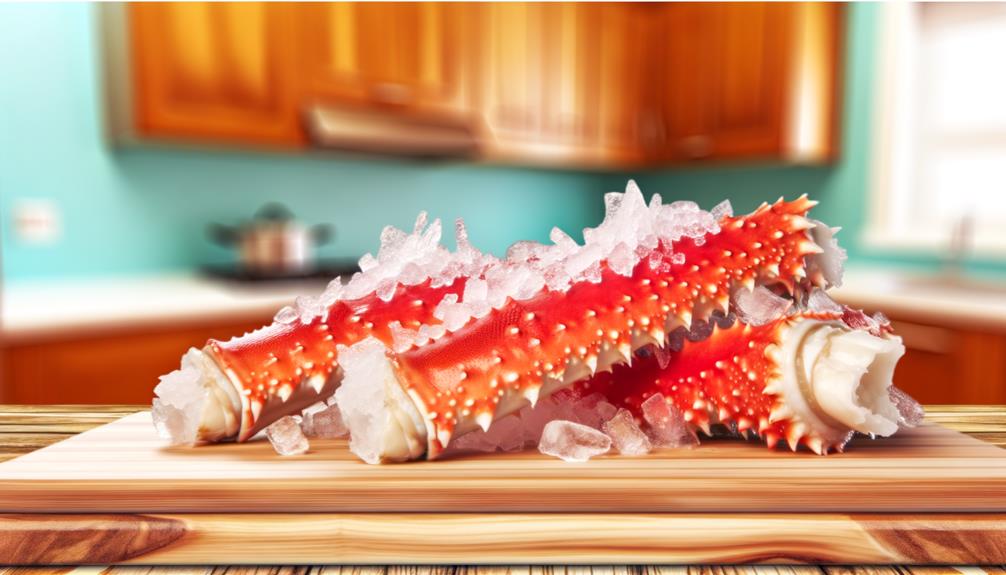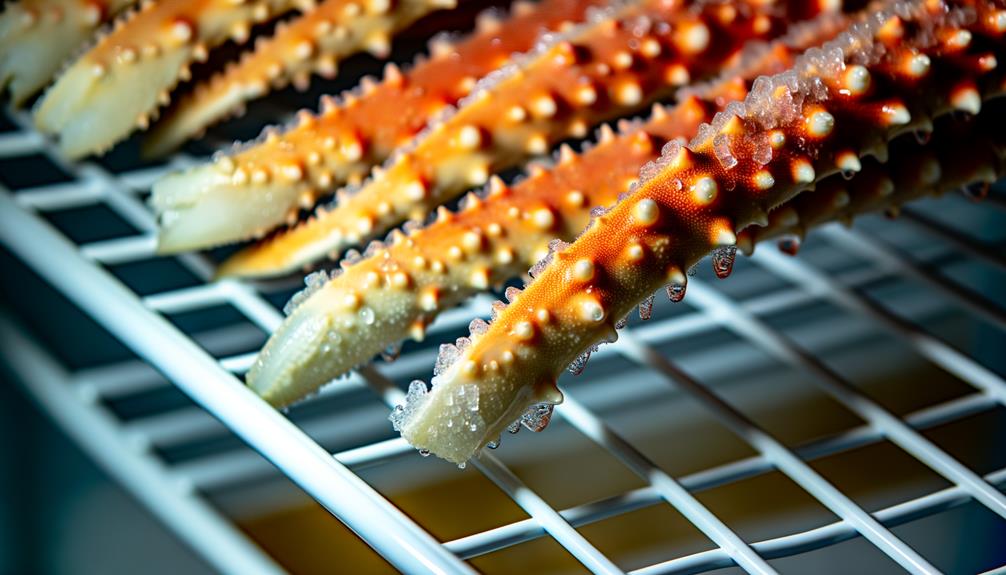Can You Ride Coconut Crabs?
You can refreeze king crab legs, but it’s important to follow specific guidelines to maintain their quality and safety. Thaw them in the refrigerator for 8-12 hours, never at room temperature.
Before refreezing, make sure they’re fresh, use airtight packaging, label and date them, and freeze quickly to prevent bacterial growth and texture degradation. Keep them at a consistent temperature below 0°F.
Rapid thawing can ruin their texture, so thaw slowly to enjoy their best flavor and nutrients. Want to make sure your king crab legs stay high-quality?

Key Takeaways
- Refreezing king crab legs can degrade their texture and flavor.
- Refreeze only if the crab legs were thawed in the refrigerator.
- Use airtight packaging to prevent freezer burn and bacterial growth.
- Label and date the crab legs before refreezing for safety.
- Consume refrozen crab legs within two days of thawing for best quality.
Understanding King Crab Legs

King crab legs are a highly sought-after seafood delicacy due to their rich, sweet flavor and substantial meat content.
When you look at king crab legs, you’re seeing the result of a meticulous harvesting process from cold, deep waters. These crustaceans are typically sourced from the Bering Sea, guaranteeing a premium product.
High in protein and low in fat, they offer a nutritious option for your diet. The impressive size and quality of the meat make them perfect for a variety of dishes, from simple steaming to gourmet recipes.
Always make sure you’re sourcing them from reputable suppliers to ensure freshness and sustainability. Knowing these details empowers you to make informed choices about this luxurious seafood.
Risks of Refreezing Seafood
While savoring the top-notch quality of king crab legs, it’s crucial to grasp the potential risks linked with refreezing seafood. Refreezing can jeopardize the quality and safety of your crab legs. Here are some critical risks to bear in mind:
- Texture Degradation: Refreezing can cause ice crystals to form, harming the delicate flesh and making it mushy.
- Flavor Loss: The process can strip away the natural flavors, leaving you with tasteless seafood.
- Nutrient Depletion: Essential nutrients, such as omega-3 fatty acids, may deteriorate with each freeze-thaw cycle.
- Bacterial Growth: Temperature fluctuations can encourage the proliferation of harmful bacteria, heightening the risk of foodborne illnesses.
Being aware of these risks helps you make informed decisions for the best seafood enjoyment.
Proper Thawing Techniques

Thawing your king crab legs properly is essential to maintain their quality, flavor, and safety. Begin by placing them in the refrigerator for 8-12 hours. This method guarantees gradual thawing, which preserves texture and taste.
For quicker results, you can submerge the crab legs in cold water for 1-2 hours, changing the water every 30 minutes. Never use hot water or leave them at room temperature, as this can promote bacterial growth and compromise food safety.
Microwave thawing is also risky, leading to uneven defrosting and potential overcooking. Stick to these reliable methods to enjoy the full culinary potential of your king crab legs while ensuring they remain safe to eat.
Safe Refreezing Steps
To refreeze king crab legs safely, make sure they’ve been thoroughly thawed and kept at a temperature below 40°F to minimize the risk of bacterial contamination.
Adhering to these steps guarantees you maintain safety without compromising your culinary freedom.
- Inspect for freshness: Confirm the crab legs show no signs of spoilage.
- Use airtight packaging: Prevent freezer burn by sealing crab legs in airtight containers or vacuum-sealed bags.
- Label and date: Clearly mark the refreeze date to keep track of storage time.
- Freeze quickly: Place the crab legs in the coldest part of your freezer immediately to minimize ice crystal formation.
Maintaining Quality and Flavor

Preserving king crab legs maintain their quality and flavor involves proper storage techniques and handling practices that preserve their natural taste and texture. First, keep the crab legs at a consistent temperature below 0°F. Fluctuating temperatures can degrade their quality.
When thawing, use the refrigerator method, allowing them to defrost slowly over 24 hours. Rapid thawing in warm water or a microwave can lead to a mushy texture and diminished flavor. Once thawed, consume within two days to safeguard peak freshness.
If refreezing, seal tightly in airtight containers or vacuum-sealed bags to prevent freezer burn. These steps safeguard your king crab legs remain as delicious as the day they were caught, giving you the freedom to enjoy them anytime.
Conclusion
Imagine your favorite book—if you repeatedly crumple and smooth its pages, it loses its charm. Similarly, refreezing king crab legs can diminish their quality.
Properly thaw them once, savor their fresh taste, and avoid refreezing to maintain their delicate texture. Studies show seafood loses flavor and nutritional value upon refreezing.
Treat your king crab legs with care, ensuring each bite offers the premium experience you deserve. Follow these guidelines for best enjoyment.






